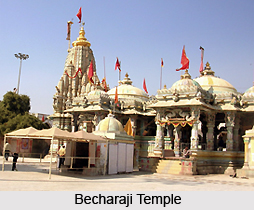 Becharaji Temple is located in Becharaji town in Mehsana district of Gujarat, India. It is 110 km from Ahmedabad and 35 km west of Mahesana. Temple of Bahuchara was built by a king called Sankhal Raj in 1152 as per the Bombay Gazetteer. The first surviving mention of the shrine was found in an inscription dating 1280 ce. The inscription also mentions about the accompanying village, Vahichara. According to the inscription no changes were made in the temple architecture until the eighteenth century, when the Gaekwads built a brick fort. The fort had its corners topped by circular towers and also had three gates that made it strong.
Becharaji Temple is located in Becharaji town in Mehsana district of Gujarat, India. It is 110 km from Ahmedabad and 35 km west of Mahesana. Temple of Bahuchara was built by a king called Sankhal Raj in 1152 as per the Bombay Gazetteer. The first surviving mention of the shrine was found in an inscription dating 1280 ce. The inscription also mentions about the accompanying village, Vahichara. According to the inscription no changes were made in the temple architecture until the eighteenth century, when the Gaekwads built a brick fort. The fort had its corners topped by circular towers and also had three gates that made it strong.
In the 1880s, the Bombay Gazetteer emphasized upon large temple funds and also to the `donations of the religious.` The temple complex during that time had wells, tanks, rest-houses also known as dharmashalas for pilgrims, public gardens, a charitable dispensary, a Gujarati school, a police station (thana) a government treasury and an office for the temple`s administration.
Presently upon entering the southern gate, it becomes clear that there is not just a single temple, but a complex of shrines. To the north of the temple complex lie the offices of the temple trust. In the inner perimeter of the fort there are performance sites and shrines dedicated to subsidiary deities such as Sahariya Mahadev, Nilakantha Mahadev and Kachroliya Hanuman. There are also memorials for important devotees such as Dada Narsinh Vir and the eighteenth-century poet, Vallabha Bhatta. One room remains packed with flimsy wooden fetishes decorated with tinsel and coconuts that are used as offerings to the goddess. Another room houses hundreds of painted figurines of children, donated by those who desire male offspring. This room is thus known as putreshna-bhuvan meaning hall of those desirous of sons. The room houses an inauguration stone which states that it was inaugurated by Narendra Modi, the chief minister of Gujarat on 14 August, 2007. Near the southern gate the shriphal sthal or sacrificial site is located which presently has become a site for offering coconuts. There is also a kunda or tank, renovated recently that stands outside the southern gate.
A small temple enclosing a sprawling, small-leafed varakhadi tree is the oldest part of the shrine. It is believed that the goddess first appeared here. Another small temple adjoining this is the madhya sthan also known as the second or intermediate place. This houses an incised sign that represents the goddess and has a locked silver door at its entrance. This particular section of the temple is said to have been built in the eighteen century by a Maratha named Fadnavis.
In 1779, the younger brother of the Maratha ruler of Baroda, Manajirao Gaekwad constructed a third structure near to the original shrine. He erected the temple in honour of the goddess as it cured him of a tumour. This part of the temple exists till today, though it has been reinstated and renovated numerous times since its construction. The third structure is the largest part of the shrine. It has been crafted beautifully with a double-domed stone temple with a spire or shikhara over its sanctum. At the entrance of this part of the temple a platform has been erected on which a statue of the goddess` rooster has been built. Devotees ascend up to the main shrine where the roof is supported by carved pillars that are beautifully crafted with mythological figures and doorkeepers. An inscription in Sanskrit and Gujarati has been inscribed on the right pillar at the entrance of the sanctum. The inscription recounts that the temple was completed in the year 1839 under the patronage of Manajirao Gayakwad. Within the sanctum in a niche on a platform a beaten silver relief of the goddess is noticeable.
Bahuchara is a virgin goddess which is quite unusual for a shrine that stands as a shaktipith. Shakti is in the form of a young girl, unaccompanied by a male consort. None of her mythology associates her with a male deity. The goddess of the temple is commonly and colourfully symbolized among the common masses as a woman who is seen seated on a rooster. This representation is however not the actual object of worship. The definite image is a yantra or a mystical diagram that represents a vulva of quartz also known as sphatika. The yantra is kept hidden from view of the common people and is covered by the silver plaque incised with an image of the goddess with her vehicle, the rooster. Devotees make offerings of small replicas of such plaques that are made of silver or other metals. The temple of Bahuchara is thus deeply revered and worshipped by the devotees who throng the temple to offer their prayers and receive blessings of the goddess.





















